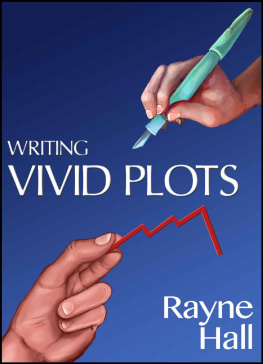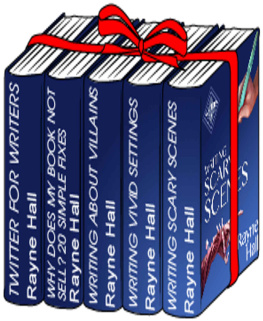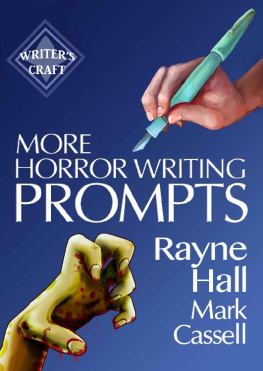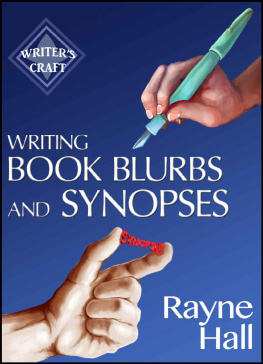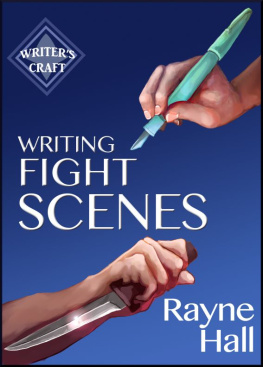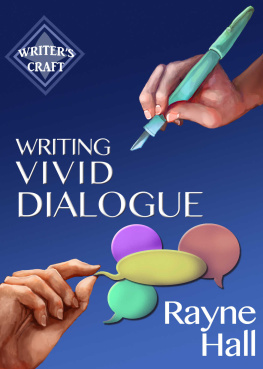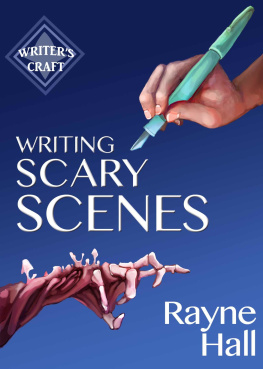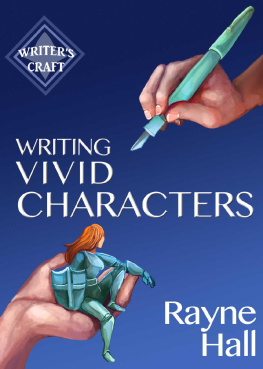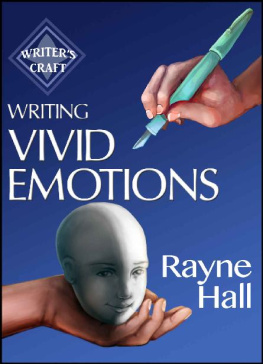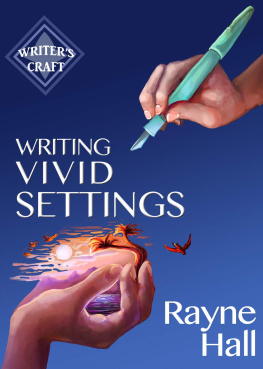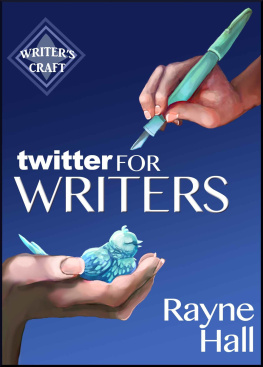Rayne Hall - Writing Vivid Plots
Here you can read online Rayne Hall - Writing Vivid Plots full text of the book (entire story) in english for free. Download pdf and epub, get meaning, cover and reviews about this ebook. year: 0, genre: Art. Description of the work, (preface) as well as reviews are available. Best literature library LitArk.com created for fans of good reading and offers a wide selection of genres:
Romance novel
Science fiction
Adventure
Detective
Science
History
Home and family
Prose
Art
Politics
Computer
Non-fiction
Religion
Business
Children
Humor
Choose a favorite category and find really read worthwhile books. Enjoy immersion in the world of imagination, feel the emotions of the characters or learn something new for yourself, make an fascinating discovery.
- Book:Writing Vivid Plots
- Author:
- Genre:
- Year:0
- Rating:3 / 5
- Favourites:Add to favourites
- Your mark:
- 60
- 1
- 2
- 3
- 4
- 5
Writing Vivid Plots: summary, description and annotation
We offer to read an annotation, description, summary or preface (depends on what the author of the book "Writing Vivid Plots" wrote himself). If you haven't found the necessary information about the book — write in the comments, we will try to find it.
Writing Vivid Plots — read online for free the complete book (whole text) full work
Below is the text of the book, divided by pages. System saving the place of the last page read, allows you to conveniently read the book "Writing Vivid Plots" online for free, without having to search again every time where you left off. Put a bookmark, and you can go to the page where you finished reading at any time.
Font size:
Interval:
Bookmark:
WRITING VIVID PLOTS
Rayne Hall
Book cover by Erica Syverson and Uros Jovanovic
2016 Rayne Hall
September 2016 Edition
All rights reserved. Do not reproduce this work in whole or in part without the authors written permission.
Do you want to give your novel a powerful story line? Do you want to power up a draft youve written?
This guide shows professional techniques for developing and structuring your fiction.
In the first four chapters, Ill present four plotting methods to choose from: the Heros Journey model, the Three-Act structure, the Goal-and-Obstacles approach and the Character Arc story. You dont need to adhere to them slavishly. Rather, I recommend that you take them, play with them and change them so they suit the story you want to write.
You can take two or more methods and layer them. Youll find that in many places the layers click together like theyre variants of the same concept. Elsewhere they may contradict each other, and in this case, you simply make an artistic choice.
This book shows solutions to plot problems such as slow beginnings, sagging middles and flat endings, and guides you to write specific story parts such as the Black Moment and the Climax.
The focus of this guide is on plotting full-length novels, but there are also chapters on plotting short stories, series and serials.
If youre new to the writers craft, you may find this book too advanced, and I suggest you start with a basic fiction writing guide. If youre an experienced author, youll inevitably be familiar with some of the concepts I present. Treat those chapters as refreshers for what you already know.
I use British English, which may look strange if youre used to American word choices, grammar, punctuation and spelling, but Im confident that you can follow the text. To avoid clunky he or she and him or her constructions, I switch between male and female pronouns. Everything in this book applies to either gender.
Now lets get to work.
Rayne
PLOTTING WITH THE HEROS JOURNEY
Some stories are millennia old and still popularthat surely makes them the most successful stories of all times. Joseph Campbell (1904-1987) identified what these stories have in common, and found that they share a similar plot structure.
The structure is called the Heros Journey.
As modern writers, we can use the same plot structuremodified of course, to suit our times, our fiction and our readersto create the same kind of power.
Here are the main stages of the Heros Journey. See if you can recognise them in your story, or if you could structure your next book with them.
1. THE ORDINARY WORLD
The main character (MC) is in her accustomed world. This is an opportunity to show her surroundings, her skills, her values and her personality. In modern novels, this section is often very short.
2. THE CALL TO ADVENTURE
A herald arrives telling the hero that he must go on a quest. This can be the boss sending him on a dangerous assignment, a client hiring the private investigator for a job, an email telling him that his little niece has disappeared, or a solicitors letter informing him that he has inherited a farm in the middle of nowhere.
The Call to Adventure combined with the Ordinary World can form the first scene of the novel: show the MC at work, and then his boss gives him the scary assignment.
3. REFUSAL OF THE CALL
At first, the MC doesnt want to go and flat out refuses. She has good reasons to decline the assignment: she isnt qualified, she doesnt believe its necessary, shes retired and doesnt want to get involved with police work again, or she promised her husband never again to take a job away from home.
But she soon learns that she must go. Shes the only one who knows the location of the bunker, the only one with the special skill, the only one the evil villain agrees to receive. Perhaps she needs to complete this mission because she failed a previous one, and this is her only chance to save her career or to regain her self-respect. Maybe the problem is partly her fault, because she let the serial killer suspect go last year, and now hes slaughtered several more innocents, so shell never forgive herself unless she brings him in. Maybe she didnt believe in the cause at first, but new events tell her this is a serious and worthwhile undertaking. Perhaps theres social pressure on her to goif she refuses, shell be branded as a coward, or her neighbours will think of her as the cop who refused to help rescue the abducted child.
So she accepts the assignment.
This refusal and acceptance of the call can happen in a few dialogue lines, or they can spread over several scenes.
4. MEETING THE MENTOR
The MC gets valuable advice from a knowledgeable, wise person. He may consult a subject expert, get a thorough briefing from his boss, seek advice from someone whos recently travelled in that country, meet up with a retired colleague, or seek out someone who has accomplished a similar quest.
Often, the mentor is reluctant to give advice. She doesnt think that the MC is experienced/skilled enough for the task and warns him not to undertake the suicidal venture, or she doesnt want to share her knowledge with someone of the wrong gender/wrong skin colour/wrong tribal affiliations/wrong attitude. Its also possible that she has buried the knowledge deep in her memory and doesnt wish to have anything to do with those matters ever again.
This creates tension because the MC desperately needs the information. He must prove himself worthy of the mentors guidance, or appeal to her loyalty or conscience to get her help.
5. PREPARING FOR THE JOURNEY
The MC gets ready for the adventure. Depending on the kind of quest, he may hastily snatch his service revolver and jump into the car, or he can devote weeks to careful planning and preparation.
Here are some things mythical heroes do to prepare. Adapt them for your story.
6. CROSSING THE THRESHOLD
The MC needs to enter a new kind of worldanother country, a new type of businessbut she cant just walk in. Theres a gatekeeper who tries to stop her, for example, a ferocious dog attacking her at the entrance to the mansion, a receptionist who wont let her pass, or a manager who tells her shes not wanted in the department.
Its important that the MC doesnt show fear, and she doesnt employ violence against the gatekeeper or defeat him. Rather, she uses courage and wit to persuade him to let her through.
Font size:
Interval:
Bookmark:
Similar books «Writing Vivid Plots»
Look at similar books to Writing Vivid Plots. We have selected literature similar in name and meaning in the hope of providing readers with more options to find new, interesting, not yet read works.
Discussion, reviews of the book Writing Vivid Plots and just readers' own opinions. Leave your comments, write what you think about the work, its meaning or the main characters. Specify what exactly you liked and what you didn't like, and why you think so.

